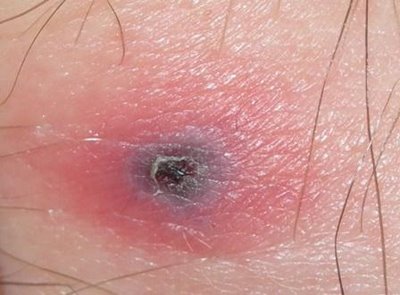Tick-borne disease: Difference between revisions
| Line 23: | Line 23: | ||
Tick-borne illnesses are caused by infection with a variety of [[pathogen]]s, including [[rickettsia]] and other types of [[bacterium|bacteria]], [[virus]]es, and [[protozoa]]. Because ticks can harbor more than one disease-causing agent, patients can be infected with more than one pathogen at the same time, compounding the difficulty in diagnosis and treatment. | Tick-borne illnesses are caused by infection with a variety of [[pathogen]]s, including [[rickettsia]] and other types of [[bacterium|bacteria]], [[virus]]es, and [[protozoa]]. Because ticks can harbor more than one disease-causing agent, patients can be infected with more than one pathogen at the same time, compounding the difficulty in diagnosis and treatment. | ||
==Tick-borne disease Epidemiology and Demographics== | ==Tick-borne disease Epidemiology and Demographics== | ||
==Tick-borne disease Classification== | ==Tick-borne disease Classification== | ||
===Bacterial=== | ===Bacterial=== | ||
Revision as of 16:12, 28 December 2015
| Tick-borne diseases | |
 | |
|---|---|
| An eschar suggestive of tick bite |
For patient information click here
Editor-In-Chief: C. Michael Gibson, M.S., M.D. [1]; Associate Editor(s)-in-Chief: Kiran Singh, M.D. [2]
Overview
Tick-borne diseases are diseases or illnesses transmitted by ticks. As the incidence of tick-borne illnesses increases and the geographic areas in which they are found expand, it becomes increasingly important that health professionals be able to distinguish the diverse, and often overlapping, clinical presentations of these diseases.
Pathophysiology
Tick-borne illnesses are caused by infection with a variety of pathogens, including rickettsia and other types of bacteria, viruses, and protozoa. Because ticks can harbor more than one disease-causing agent, patients can be infected with more than one pathogen at the same time, compounding the difficulty in diagnosis and treatment.
Tick-borne disease Epidemiology and Demographics
Tick-borne disease Classification
Bacterial
| Disease | Organism | Vector | Endemic Regions | |
|---|---|---|---|---|
| Borreliosis (Lyme Disease) | Borrelia burgdorferi sensu lato (bacterium) | Deer Tick (Ixodes scapularis, I. pacificus, I. ricinus, I. persulcatus) | Widespread:
| |
| Relapsing Fever | Borrelia Species; Borrelia hermsii, Borellia Parkeri, Borellia duttoni, Borrelia miyamotoi | Ornithodoros species | Widespread:
| |
| Typhus (Diseases associated with the transfer of Rickettsia Bacteria as listed below) | ||||
| Rocky Mountain Spotted Fever | Rickettsia Rickettsii | Wood Tick (Dermacentor Variabilis), D. andersoni | United States:
| |
| Helvetica Spotted Fever | Rickettsia Helvetica | Ixodes Ricinus (European) | Europe:
| |
| Ehrlichiosis Anaplasmosis | Ehrlichia Chaffeensis, E. Equi | Lone Star Tick (Amblyomma Americanum), Ixodes Scapularis | United States:
| |
| Tularemia | Francisella Tularensis | D. Andersoni, D. Variabilis | United States:
| |
Viral
| Disease | Organism | Vector | Endemic Regions |
|---|---|---|---|
| Tick-borne Meningoencephalitis | TBEV virus | Ixodes Scapularis, I. Ricinus, I.persulcatus | Widespread:
|
| Colorado Tick Fever | CTF virus | Dermacentor andersoni | United States:
|
| Crimean-Congo Hemorrhagic Fever | CCHF virus | Hyalomma marginatum, Rhipicephalus bursa | Widespread:
|
| Severe Febrile Illness | Heartland Virus | Lone Star Tick (amblyomma americanum) | United States:
|
Protozoan
| Disease | Organism | Vector | Endemic Regions |
|---|---|---|---|
| Babesiosis | Babesia microti, B divergens, B.equi | Ixodes Scapularis, I. pacificus | Widespread:
|
Differentiating Tick-Borne Disease
Diagnosis
Risk Factors
People who spend time outdoors and/or have pets that go outdoors are at risk for tick-borne disease.
Physical Examination
A round red rash with a 2-5 mm central black area (eschar, an area of dead tissue)as shown in the photo is suggestive of a tick bite.
Laboratory Findings
In general, specific laboratory tests are not available to rapidly diagnose tick-borne diseases.
Treatment
Medical Therapy
If there is a collection of pus, the area will need to be incised and drained. Antibiotic treatment is often justified based on clinical presentation alone. Doxycycline is often used to treat suspected tick borne-disease. Usually one dose is given to cover Lyme disase. An IV dose of a cephalosporin followed by Keflex 500 mg PO q 6 hours is given to treat the surrounding cellulitus. For hospital workers and others who have recently been in the hospital, bactrim twice a day is given to cover Methicillin resistant Staphylococcus Aureus (MRSA).